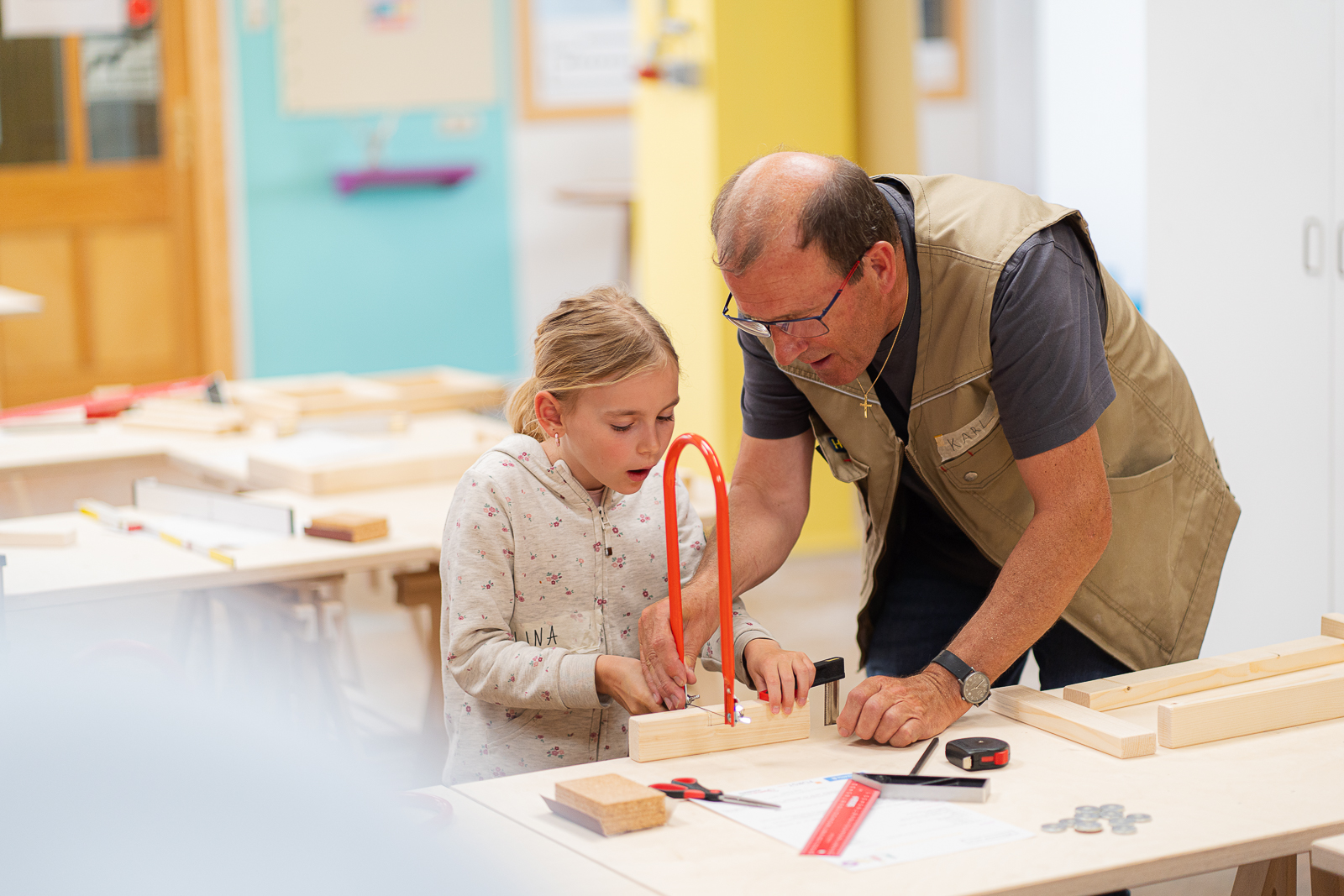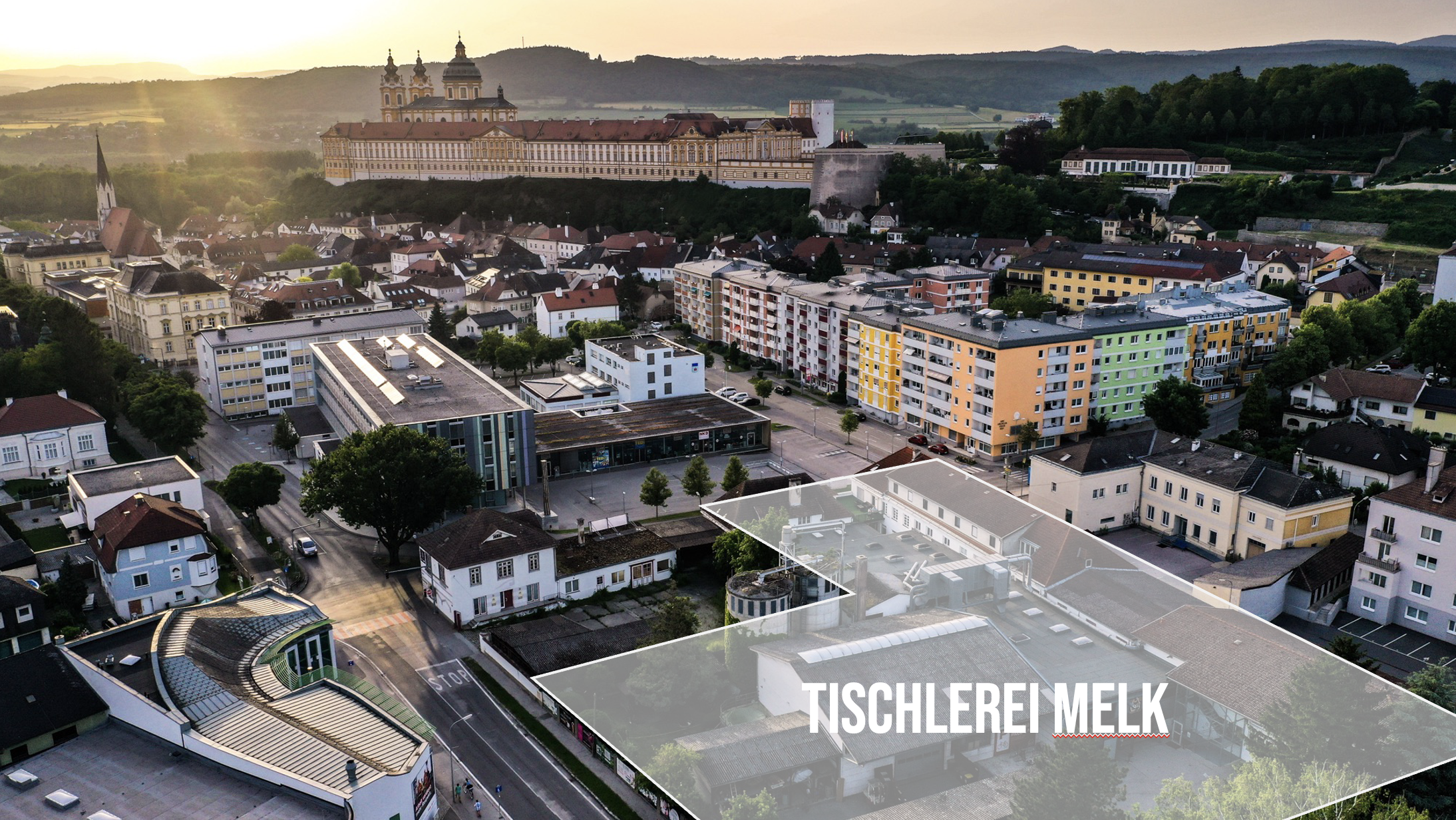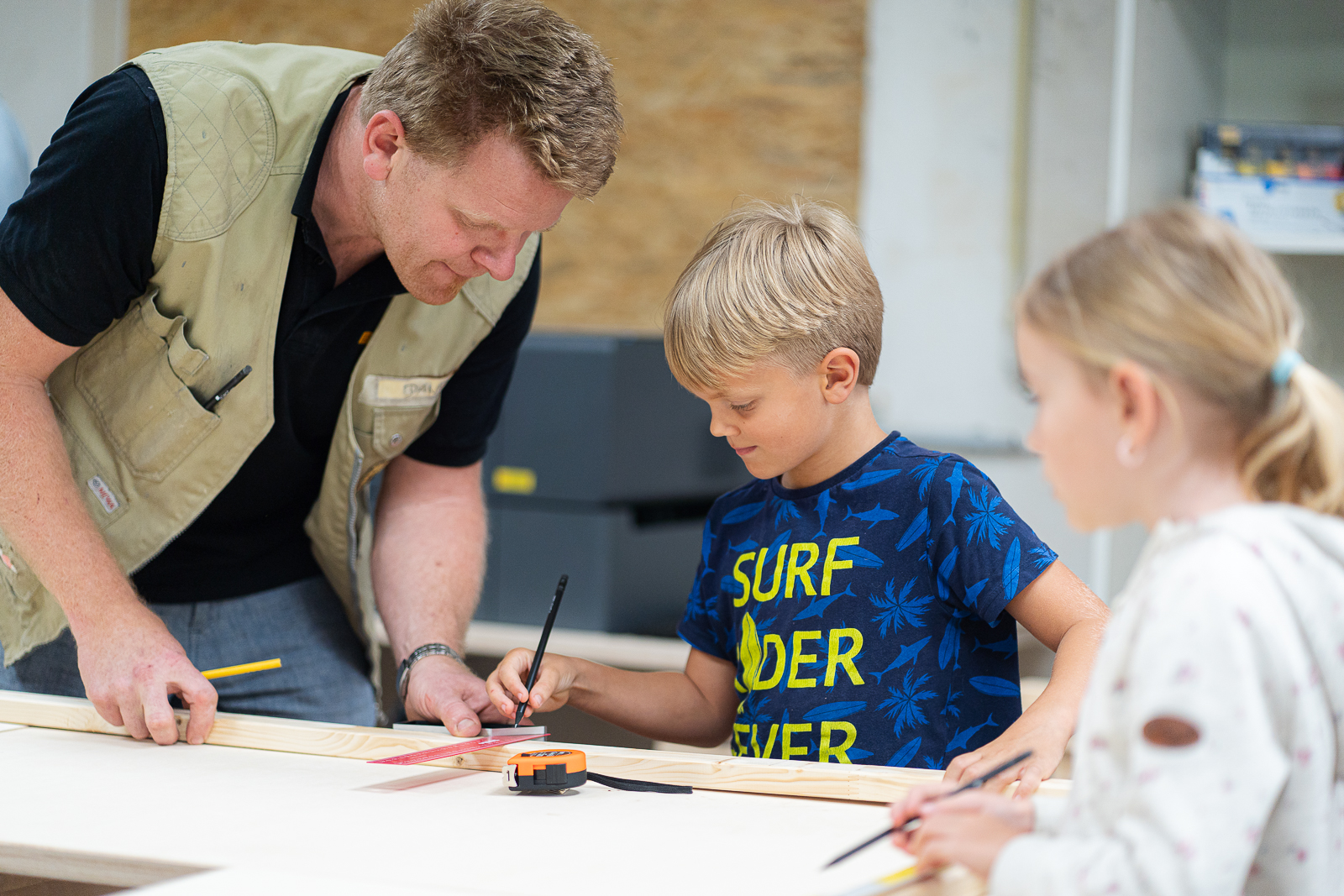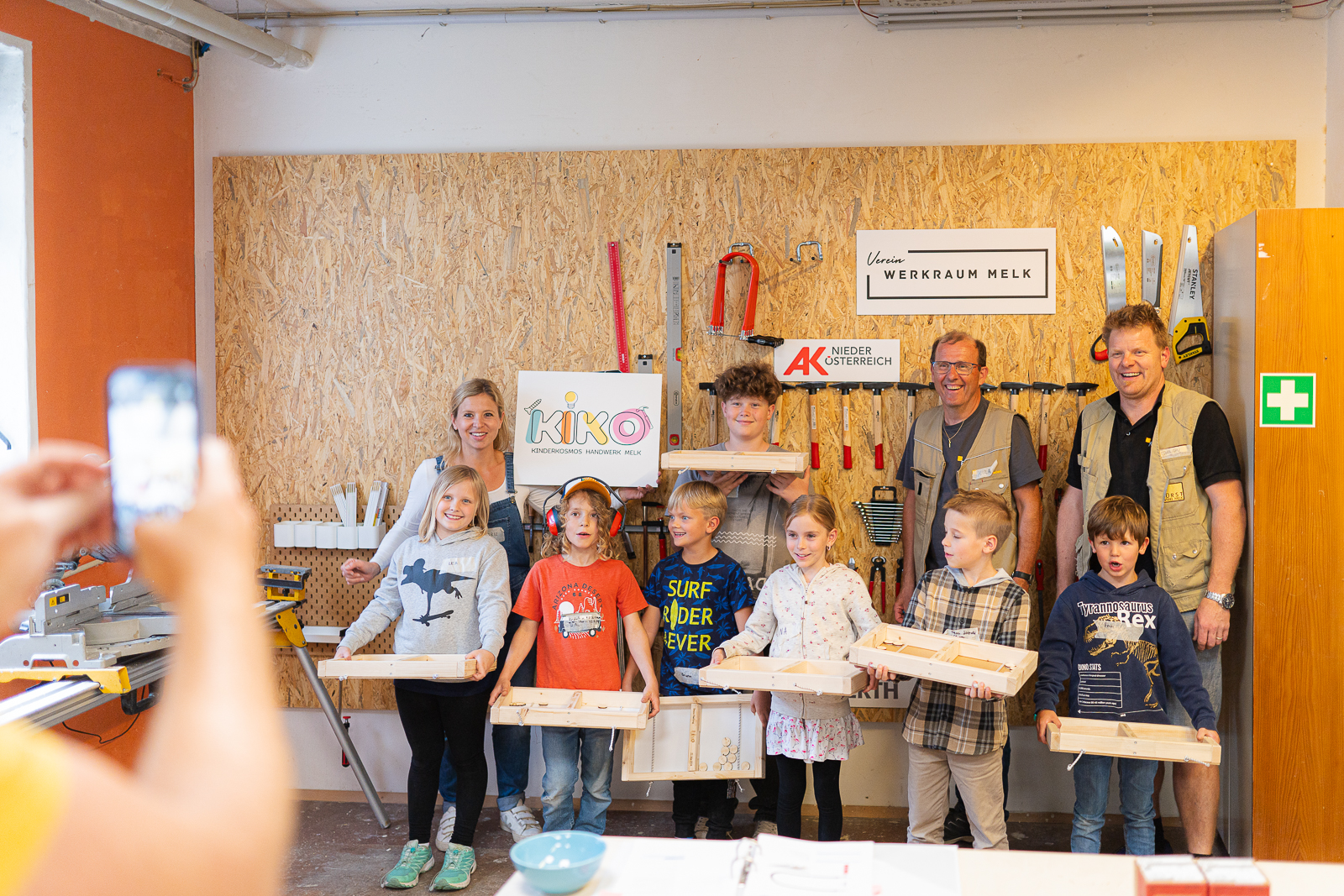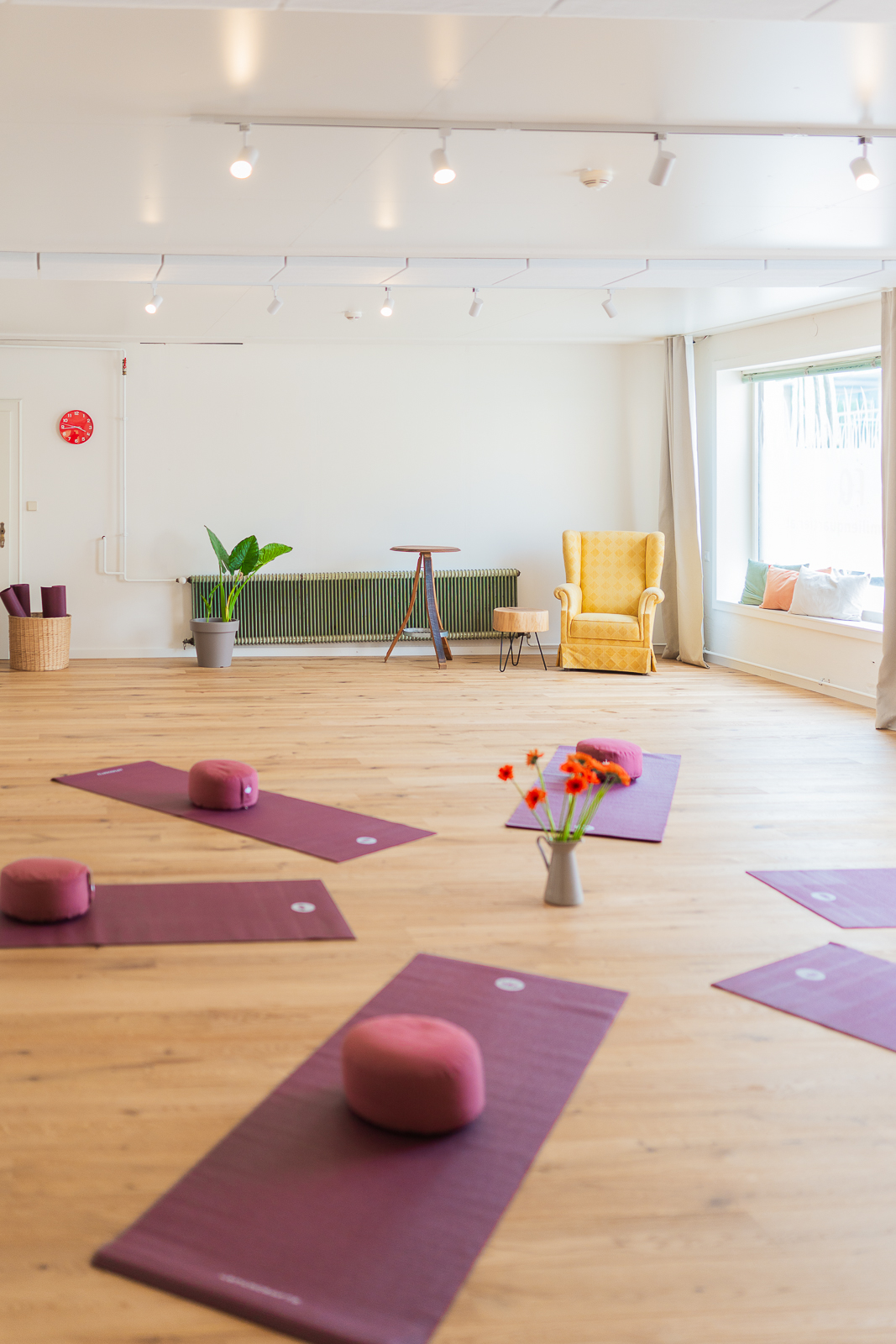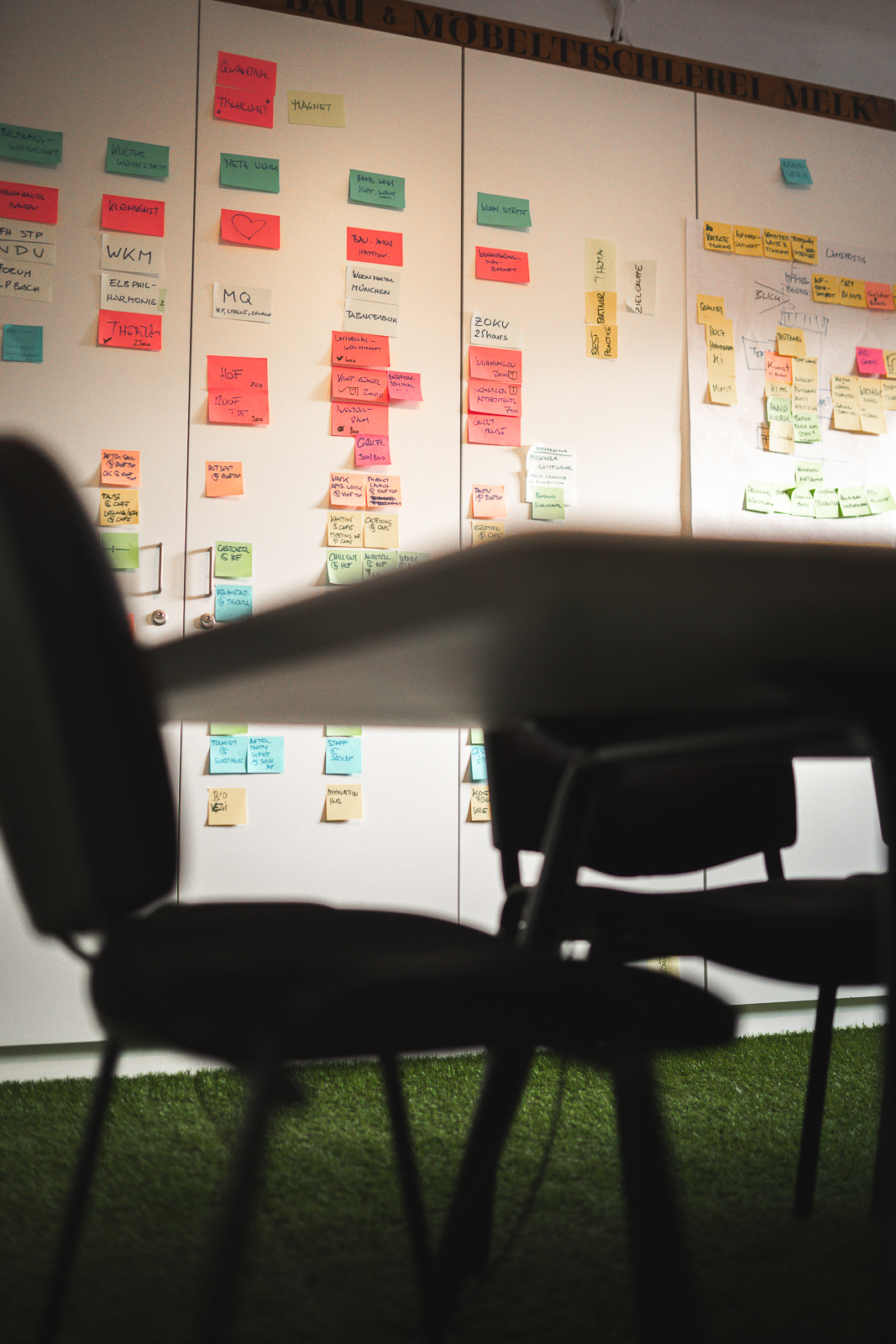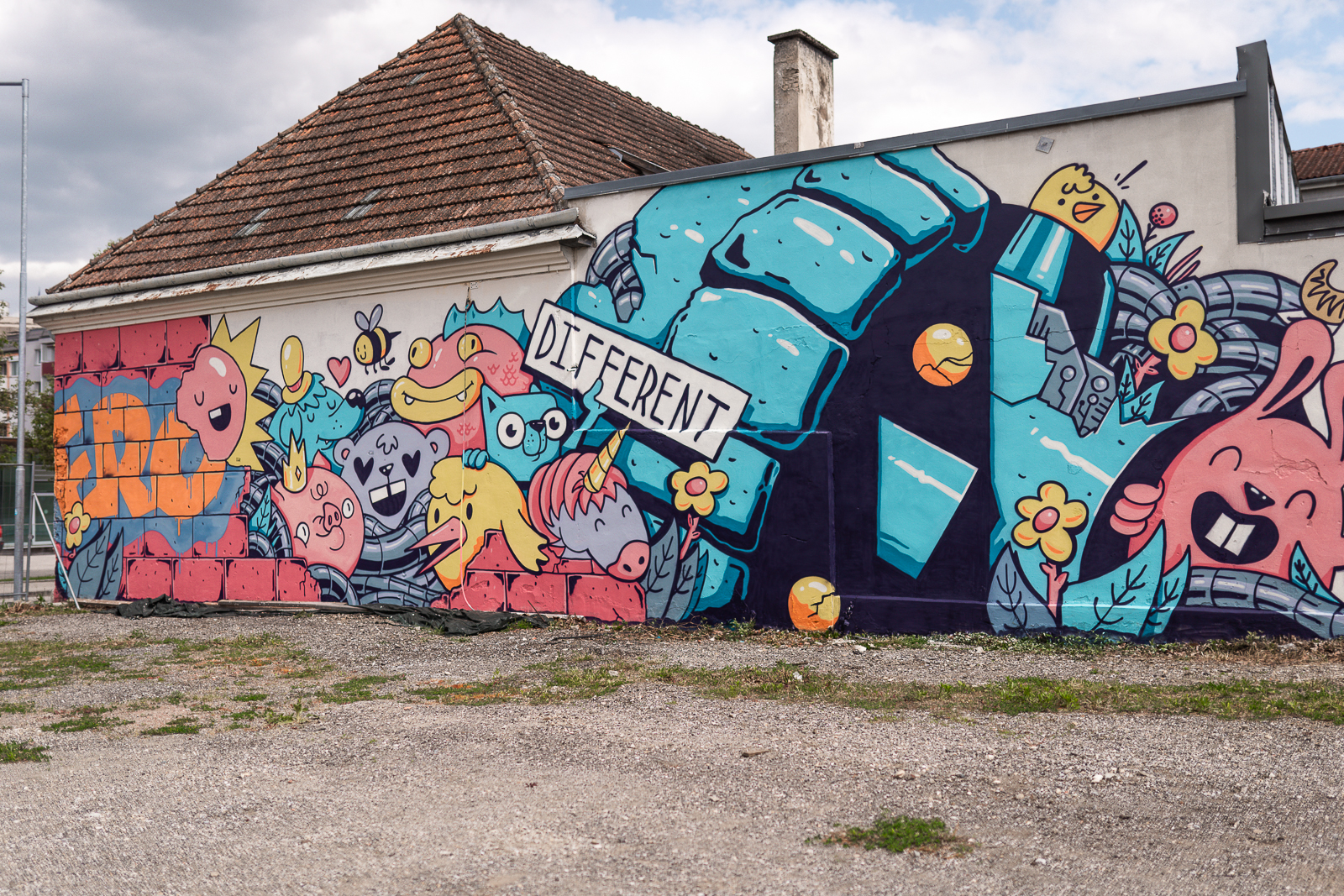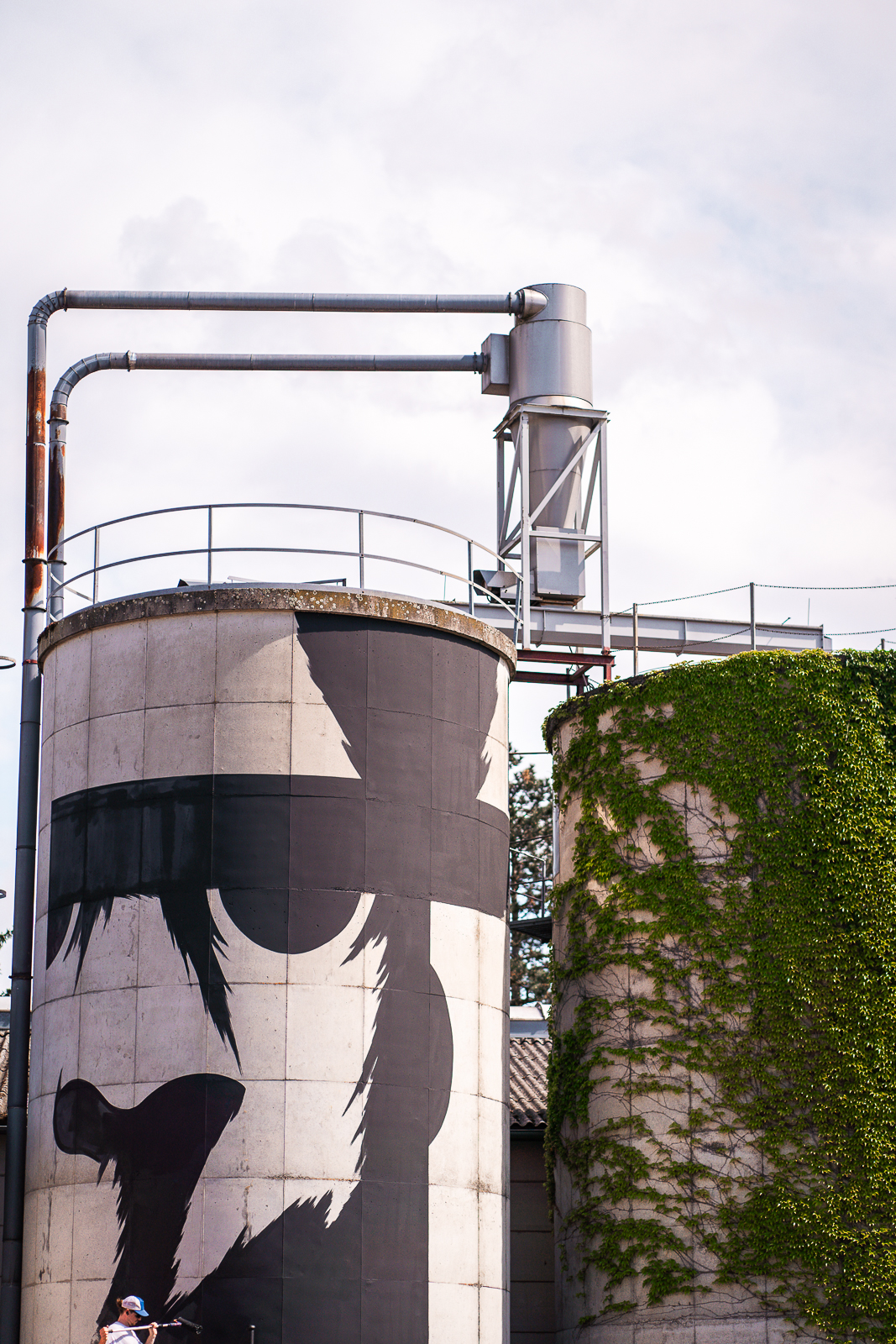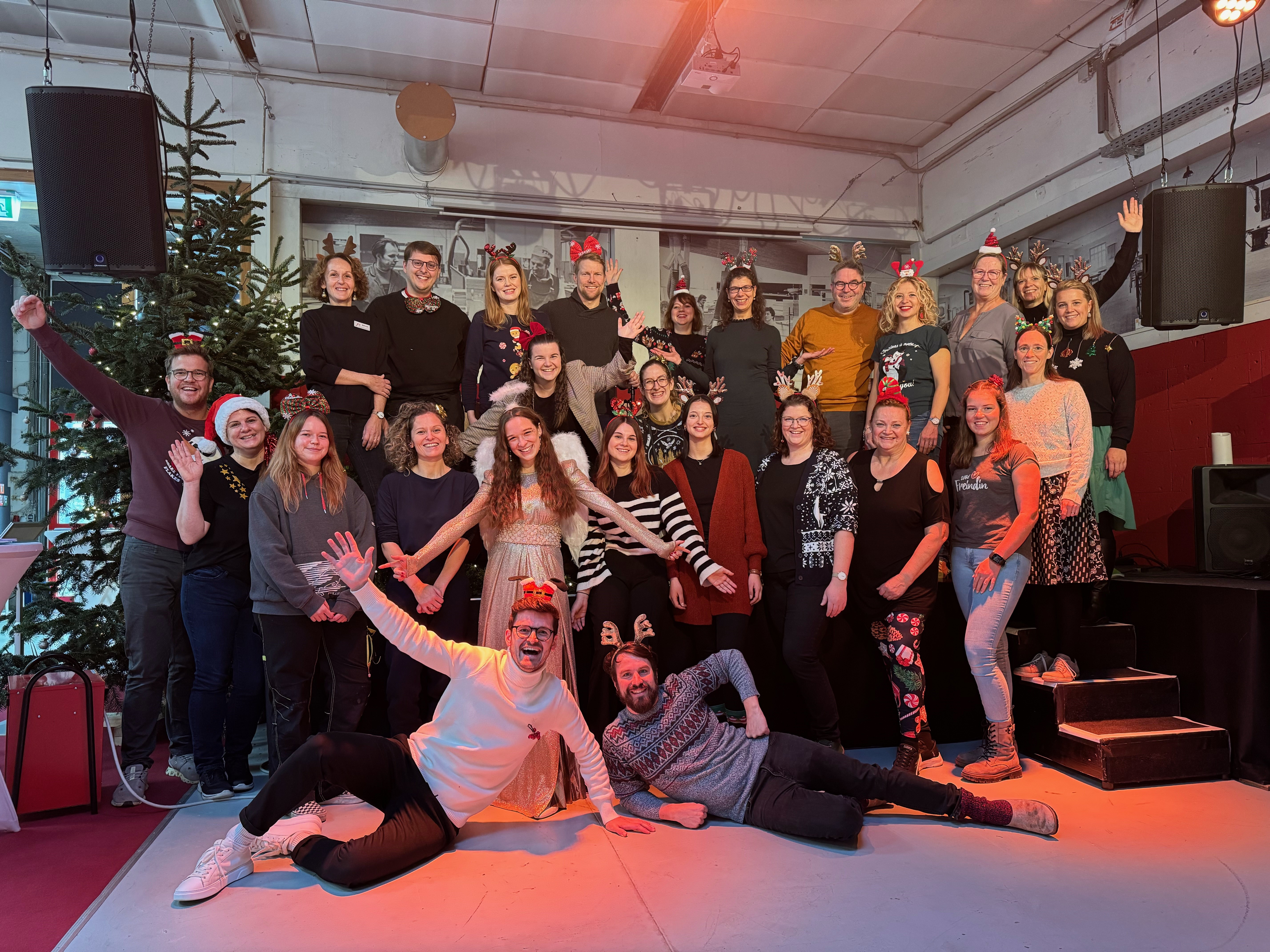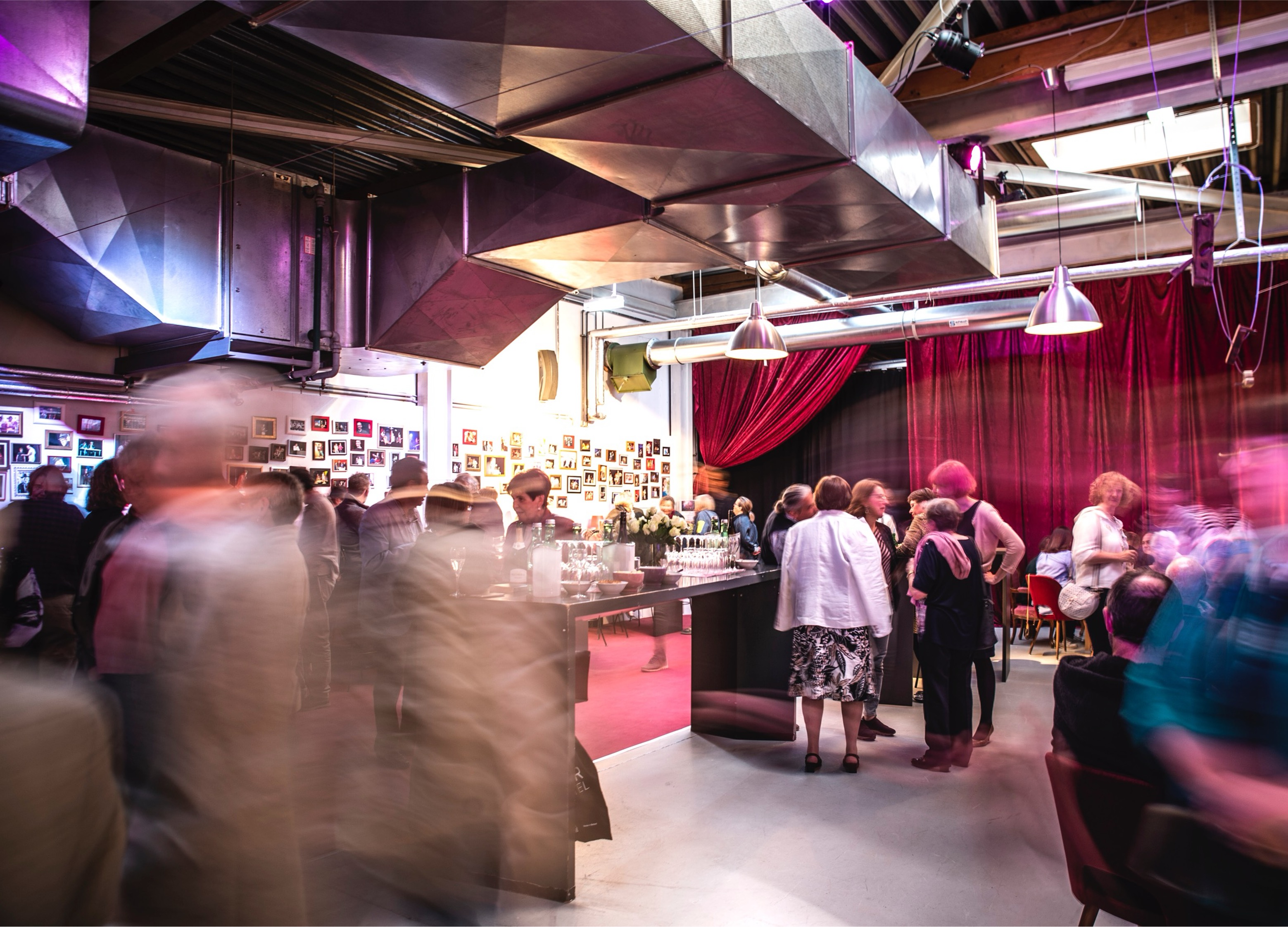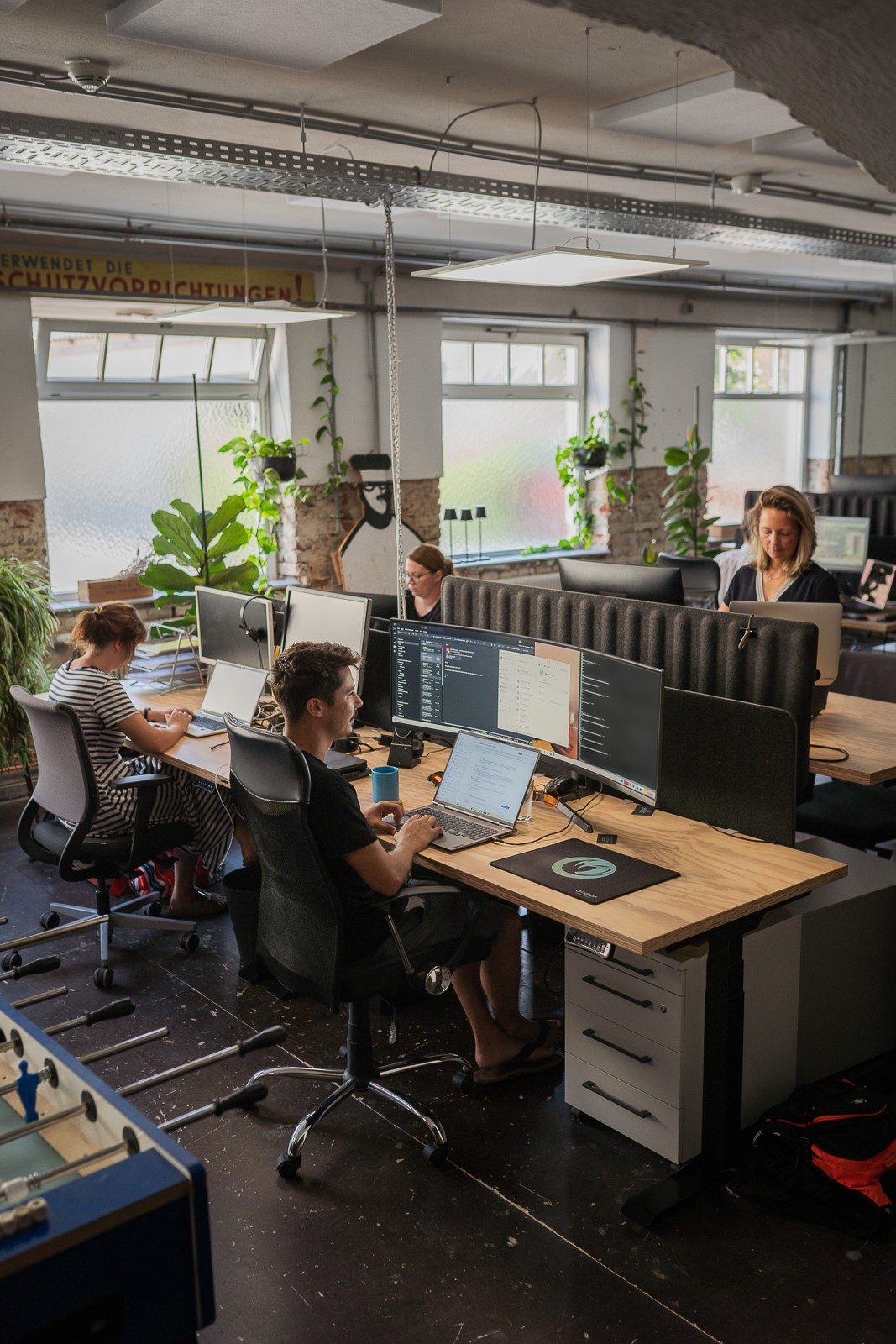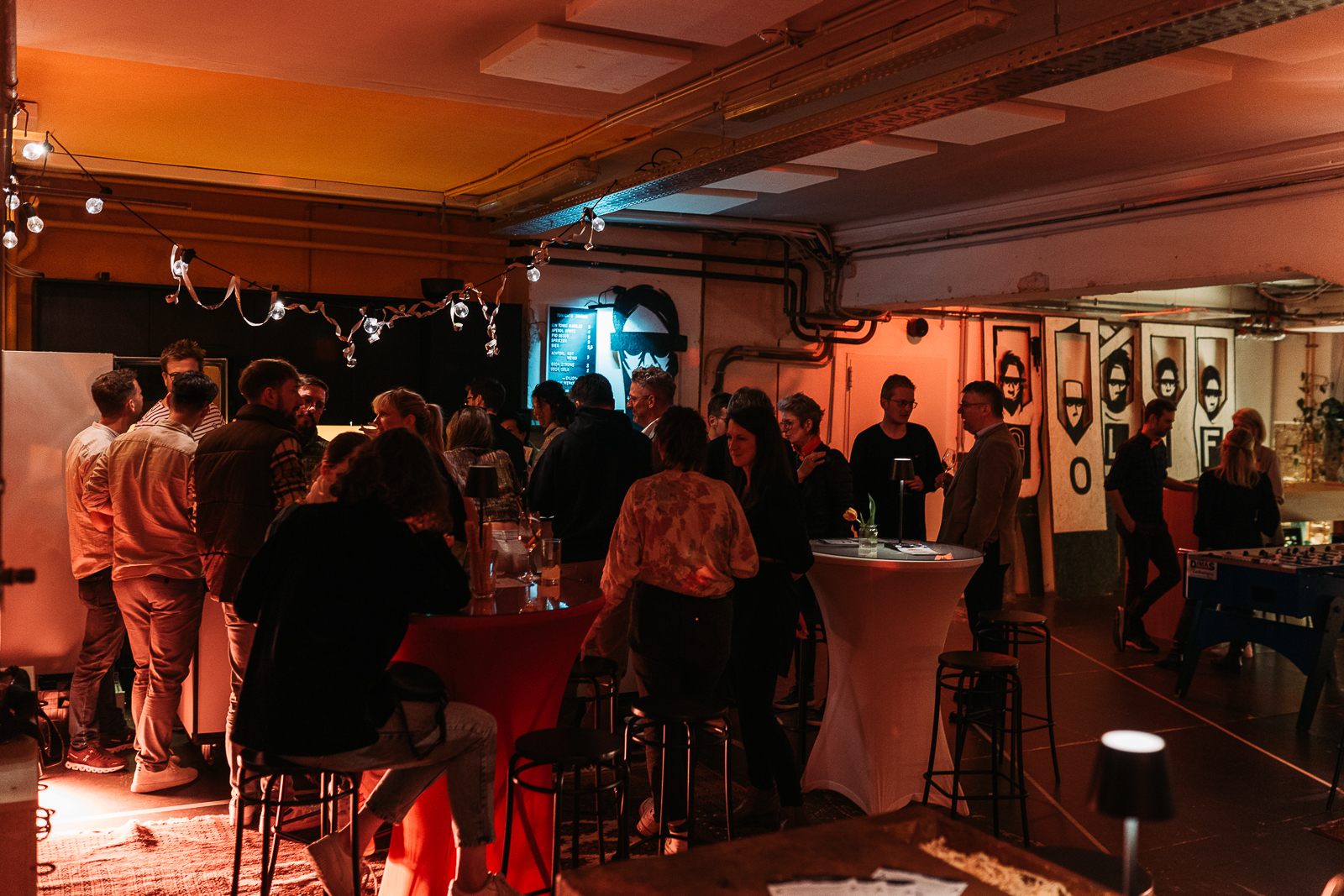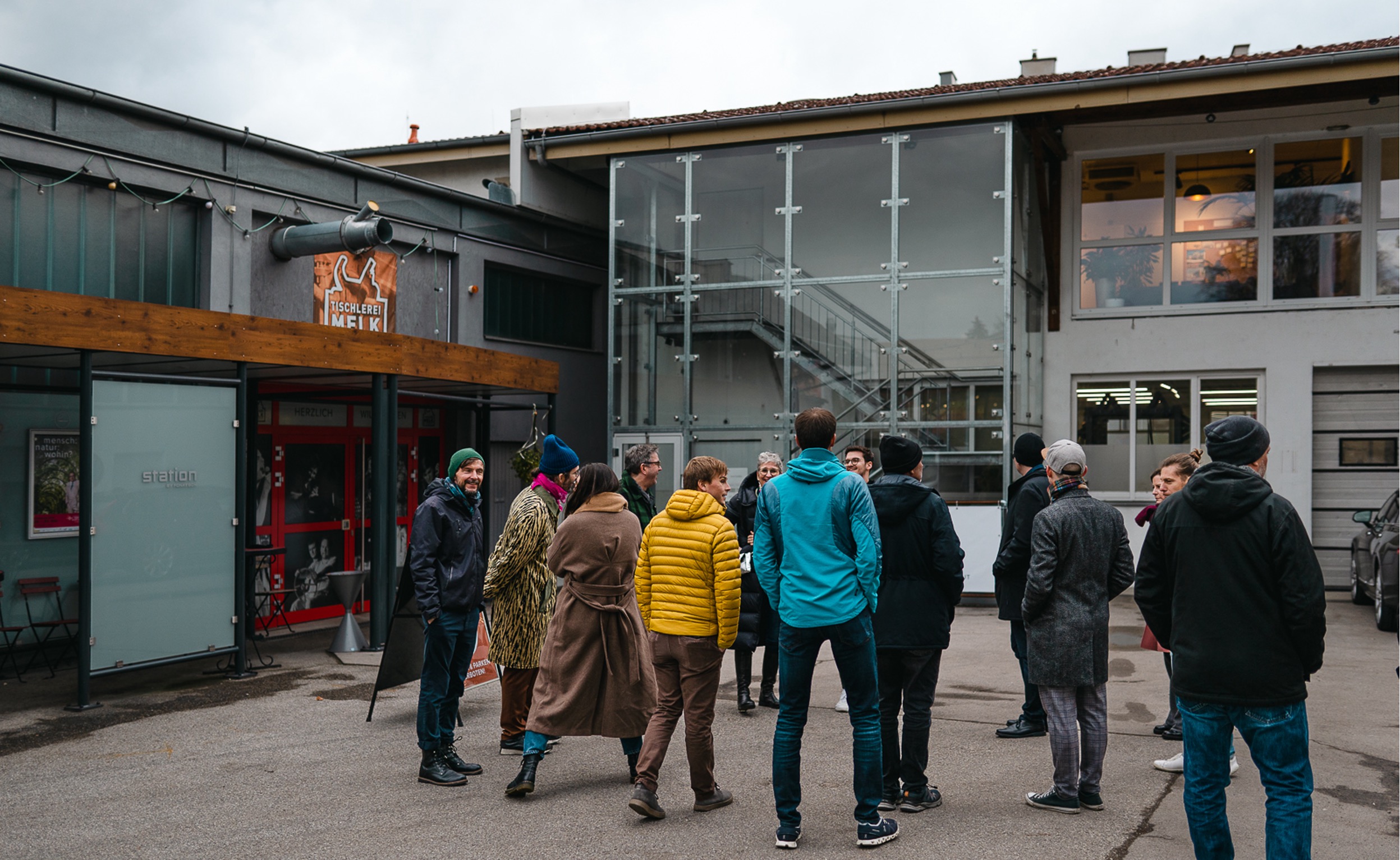Regaining a sense of belonging
NEB-Tischlerei-Melk
NEB-Tischlerei-Melk: rediscovering Europe’s rural potential and heritage as drivers for the future
This project led to the successful transformation of a brownfield into a lively NEB-district next to the world famous Abbey Melk. Over 1,000 people contributed to shaping this NEB-district which may be the first in Europe’s rural area. The 100 year old former carpentry buildings tell a story of craft tradition, aesthetics, art and community. The project makes the NEB relevant to people and contributes to solving the climate crisis, enlarging the number of skilled workers and revitalizing cities.
Austria
Regional
The project was implemented in Melk.Consequently, it impacts especially the city of Melk and its surrounding communities.However, analyzes within the project development show a potential that the project may affect also the Linz-Vienna region.
It addresses urban-rural linkages
It refers to a physical transformation of the built environment (hard investment)
Yes
2024-12-31
Yes
no risk of double funding because this submitted project covers the transformation of the brownfield into a NEB district and has not received funding yet.
NextGenerationEU, 2024-2025 - name of the programme: "Flächenrecycling", managed by Kommunalkredit Public Consulting - that project covered the analysis of potentials for further future development, such as a change of the heating and cooling systems or geothermal energy potential.
No
No
As a representative of an organisation
The target of the project has always been to aim at highest ambition levels of the NEB-compass and to address all core values. It turns out if this approach is taken seriously, we are talking about a cross generational multi year process. “NEB Tischlerei Melk” achieved the transformation of a brownfield into a NEB-district on the rural area of Melk.
- Sustainability: converting a brownfield into a lively NEB-quartier – extending the building lifespan of 100 year old historic buildings, safe grey energy and conserve history and tradition
- Beautiful: creating a hotspot for art offering art exhibitions, a cabaret and theatre stage for cultural events, cross-generational craftsworkshops for kids and large-scale-paintings on outer walls
- Together: creating a low-treshold, open to all and welcoming community space – both for visitors and contributors to the project development
- principles: the development of the project has never been top down but always bottom up. More than 1,000 people have contributed to the project within a participation and co-creation process managed by Lukas Fürst - from international experts to local neighbours – to implement the NEB quarter together. The open, low-treshold and welcoming approach to participate has led to an emotional connection of people to the local project but also to the European Union as the NEB initiative has always been emphasised this is strong foundation of the project
instead of a brownfield, a lively town center – the “NEB Tischlerei Melk” – has been created for people: a place where they can meet, enjoy their free time, art and culture and co-create. As Melk is visited by more than 1 Mio tourists per year due to its worldfamous Abbey Melk, the NEB quarter has a massive potential to impact numerous people in every day life.
The projects contributes to solving the climate crisis, reducing the shortage of skilled workers, regaining a sense of belonging and togetherness, revitalizing struggling town centers
- Sustainability: converting a brownfield into a lively NEB-quartier – extending the building lifespan of 100 year old historic buildings, safe grey energy and conserve history and tradition
- Beautiful: creating a hotspot for art offering art exhibitions, a cabaret and theatre stage for cultural events, cross-generational craftsworkshops for kids and large-scale-paintings on outer walls
- Together: creating a low-treshold, open to all and welcoming community space – both for visitors and contributors to the project development
- principles: the development of the project has never been top down but always bottom up. More than 1,000 people have contributed to the project within a participation and co-creation process managed by Lukas Fürst - from international experts to local neighbours – to implement the NEB quarter together. The open, low-treshold and welcoming approach to participate has led to an emotional connection of people to the local project but also to the European Union as the NEB initiative has always been emphasised this is strong foundation of the project
instead of a brownfield, a lively town center – the “NEB Tischlerei Melk” – has been created for people: a place where they can meet, enjoy their free time, art and culture and co-create. As Melk is visited by more than 1 Mio tourists per year due to its worldfamous Abbey Melk, the NEB quarter has a massive potential to impact numerous people in every day life.
The projects contributes to solving the climate crisis, reducing the shortage of skilled workers, regaining a sense of belonging and togetherness, revitalizing struggling town centers
Intergenerational community-building & knowledge transfer
creating new identy for our living environment
rural-innovation & revitalisation
collaborative co creation
brownfield-transformation
The project aimed at the transformation of an old industrial brownfield in the rural city center of Melk into an attractive hotspot of regional innovation. Within the project duration (2021 - 2024) a total number of 1,400 m² of the former brownfield has been revitalized as the "NEB Tischlerei Melk".
The main sustainability goal was to show how to achieve a long term extension of building lifespans, which has been successfully achieved: The oldest existing buildings on the site of the "NEB Tischlerei Melk" quarter are already nearly 100 years old. Instead of being demolished, they could be revitalized - this saves grey energy, boosts a circularity approach in the building sector, is economically sustainable and preserves the history of the area. Historic buildings no matter what their former function has been hold a great potential to give people a feeling of belonging, an understanding for their cultural and traditional heritage. The emphasis on building culture and the importance of craft traditions can be conveyed much more credibly in historical buildings than in a new building. This solution is exemplary because, according to estimates, there are thousands of empty, heavily sealed industrial brownfield sites in Europe's cities and towns and old buildings are often demolished instead of increasing their life cycle through needs-based reuse concepts.
The main sustainability goal was to show how to achieve a long term extension of building lifespans, which has been successfully achieved: The oldest existing buildings on the site of the "NEB Tischlerei Melk" quarter are already nearly 100 years old. Instead of being demolished, they could be revitalized - this saves grey energy, boosts a circularity approach in the building sector, is economically sustainable and preserves the history of the area. Historic buildings no matter what their former function has been hold a great potential to give people a feeling of belonging, an understanding for their cultural and traditional heritage. The emphasis on building culture and the importance of craft traditions can be conveyed much more credibly in historical buildings than in a new building. This solution is exemplary because, according to estimates, there are thousands of empty, heavily sealed industrial brownfield sites in Europe's cities and towns and old buildings are often demolished instead of increasing their life cycle through needs-based reuse concepts.
Aesthetics has always played a natural key role in the 150-year-old traditional family business of “Fürst Holding GmbH”, as its focus is on the production of aesthetic furniture. The carpentry business was relocated in 2008 due to space constraints as the business and number of employees grew continuously. The first impulse use of the vacant area was a cabaret stage. The so called “Tischlerei Kulturwerkstatt” has grown into an established location with national significance and more than 100,000 visitors so far. The site now hosts art exhibitions and social events. With the development of the property into a New European Bauhaus - quarter, the focus on art was further increased - particularly visible in the design of the outer wall and the silo with large-scale works of art (total number of 6 murals in Melk within the project). Then the “Kinderkosmos Melk” initiative was launched - a workroom built in the old production hall on the site, where children are taught crafts by retired skilled workers. A central component of the participatory, co-creative competition process is to jointly develop the area into an aesthetic building ensemble.
This project is an example for converting a former brownfield into a lively quarter because it shows a promising strategy: the initial step was to create a space for humor, art, programs children and community - this automatically leads to the transformation of a potential “lost place” into a lively place where people can enjoy themselves and experience community. In addition, aesthetics must be designed together in a participatory way to allow a feeling of belonging, to make sure the building reflects the identity of a locality and a European region.
This project is an example for converting a former brownfield into a lively quarter because it shows a promising strategy: the initial step was to create a space for humor, art, programs children and community - this automatically leads to the transformation of a potential “lost place” into a lively place where people can enjoy themselves and experience community. In addition, aesthetics must be designed together in a participatory way to allow a feeling of belonging, to make sure the building reflects the identity of a locality and a European region.
The main goals in terms of inclusion were to create an open space in which everyone can feel welcome and which encourages people to meet. Low-threshold and openness are practiced for both visitors and providers on the site (in order to prevent people from feeling excluded) - for example, by having diverse and well-known artists perform who also motivate diverse people to visit the “NEB Tischlerei Melk”. “Tischlerei Kulturwerkstatt” is a “gateway to the world in rural area” especially for young people and people for whom going to the theater in a more expansive city like Vienna, Linz or Salzburg is simply not possible or affordable.
Openness and inclusion are also embodied in the fact that Fürst Holding GmbH is a “space provider” and is open to possible uses for the area whose concepts and ideas meet the criteria of the NEB compass.
In order to ensure that people can afford to participate in the activities and offers of “NEB Tischlerei Melk”, Fürst Holding GmbH deliberately provides affordable offers such as the new found "Dream Factory Melk" hostel - a high-quality, inexpensive accommodation concept (less than €30 per night)
The project is an example as inclusion is key principle not only for users, but also for providers. For the future development of the area, design for all principles will be applied and implemented in both the barrier-free equipment and the selection of low-threshold offers. This means that everyone should feel attracted to the area and actually come to visit it thanks to a diverse, wide range of offerings.
Community building and participatory development by founding a co-working space and implementing afterwork events, which also created an entrepreneurial spirit of starting new businesses and collaborations. community building was sparked by a huge number of networking activities especially driven by Lukas Fürst, who has already invited around 500 experts to the area to share their ideas and inputs.
Openness and inclusion are also embodied in the fact that Fürst Holding GmbH is a “space provider” and is open to possible uses for the area whose concepts and ideas meet the criteria of the NEB compass.
In order to ensure that people can afford to participate in the activities and offers of “NEB Tischlerei Melk”, Fürst Holding GmbH deliberately provides affordable offers such as the new found "Dream Factory Melk" hostel - a high-quality, inexpensive accommodation concept (less than €30 per night)
The project is an example as inclusion is key principle not only for users, but also for providers. For the future development of the area, design for all principles will be applied and implemented in both the barrier-free equipment and the selection of low-threshold offers. This means that everyone should feel attracted to the area and actually come to visit it thanks to a diverse, wide range of offerings.
Community building and participatory development by founding a co-working space and implementing afterwork events, which also created an entrepreneurial spirit of starting new businesses and collaborations. community building was sparked by a huge number of networking activities especially driven by Lukas Fürst, who has already invited around 500 experts to the area to share their ideas and inputs.
The citizens benefit from this project because, instead of an unused brownfield, a lively town center – the “NEB Tischlerei Melk” – has been created: a place where they can meet other people and enjoy their free time. The historic old town of Melk is in need of new impulses that increase the attractivity for new shops, restaurants and businesses instead of facing the threat that shops and business premises are closed down.
Citizens are offered a high-quality, barrier-free and low-threshold offering of art and culture. A family center (named “Familienquartier”) and craftsman workshops for children (“Kinderkosmos Melk”) are high-quality offerings on the site, especially for families. Citizens who want to start a company, work remotely or are self-employed benefit from the founded co-working-space (“Werk 3”). The new hostel offers affordable accommodation, stimulates local tourism and attracts new target groups (e.g. cyclists, young people, students). The project has also served as a practical example of town center revitalization for student working groups and universities.
The city government was closely involved in the development. The “NEB Tischlerei Melk” project is the largest individual piece of land in a larger urban development project and takes on the role of a pioneer in urban development.
In addition to more than 500 expert talks, 16 themed workshops took place and 8 focus groups (local-regional-nationa-international level) were formed within the co-creation and participation process. As a result, more than 1,000 people were part of the process and contributed to the "NEB Tischlerei Melk". Given the fact that Melk has less than 6,000 inhabitants, this shows that the participation process was strongly emphasized.
Citizens are offered a high-quality, barrier-free and low-threshold offering of art and culture. A family center (named “Familienquartier”) and craftsman workshops for children (“Kinderkosmos Melk”) are high-quality offerings on the site, especially for families. Citizens who want to start a company, work remotely or are self-employed benefit from the founded co-working-space (“Werk 3”). The new hostel offers affordable accommodation, stimulates local tourism and attracts new target groups (e.g. cyclists, young people, students). The project has also served as a practical example of town center revitalization for student working groups and universities.
The city government was closely involved in the development. The “NEB Tischlerei Melk” project is the largest individual piece of land in a larger urban development project and takes on the role of a pioneer in urban development.
In addition to more than 500 expert talks, 16 themed workshops took place and 8 focus groups (local-regional-nationa-international level) were formed within the co-creation and participation process. As a result, more than 1,000 people were part of the process and contributed to the "NEB Tischlerei Melk". Given the fact that Melk has less than 6,000 inhabitants, this shows that the participation process was strongly emphasized.
The Fürst family began the process of transforming the brownfield into an NEB-neighborhood through an intensive exchange process. Lukas Fürst conducted over 500 discussions, some in 1:1 settings, some with larger work teams. The discussion partners included experts from the areas of sustainability, inclusion, aesthetics, art and culture, politics and economics, as well as real estate developers, neighborhood developers and researchers as well as citiziens and neighbours. Furthermore, international educational trips to Europe (DE, CH, DK, ES, IT), VAE, Indonesia and the USA were organized in order to promote international personal and professional exchange.
Universities, educational institutions, national coordination and contact points, companies and initiatives as well as personalities such as the former Vice President of the European Parliament, Dr. Othmar Karas, made statements of support for the project. One of the partners is "FH St. Pölten" which is one of the leading members of the EUDRES-Alliance as driver for sustainable and smart regions in Europe. Lukas Fürst has been a jury member for the 2nd International E³UDRES² Hackathon.
The project addresses a wide range of topics and challenges and is constantly being developed as an NEB district. The support of those involved ranged from co-development, technical collaboration to the role of project ambassadors. On the one hand, this made it possible to improve the quality of the results and the speed of project implementation. On the other hand, it creates trust in the project and prevents it from being perceived as pure idealism with no implementation character or an overwhelming multidimensional project. Therefore, the intensive exchange of discussions and broad project support were crucial for successful implementation.
Universities, educational institutions, national coordination and contact points, companies and initiatives as well as personalities such as the former Vice President of the European Parliament, Dr. Othmar Karas, made statements of support for the project. One of the partners is "FH St. Pölten" which is one of the leading members of the EUDRES-Alliance as driver for sustainable and smart regions in Europe. Lukas Fürst has been a jury member for the 2nd International E³UDRES² Hackathon.
The project addresses a wide range of topics and challenges and is constantly being developed as an NEB district. The support of those involved ranged from co-development, technical collaboration to the role of project ambassadors. On the one hand, this made it possible to improve the quality of the results and the speed of project implementation. On the other hand, it creates trust in the project and prevents it from being perceived as pure idealism with no implementation character or an overwhelming multidimensional project. Therefore, the intensive exchange of discussions and broad project support were crucial for successful implementation.
The following groups of people were included in the project development: artists, cabaret artists, actors, directors, photographers, exhibition curators, sustainability experts, renewable energy experts (including storage systems and hydrogen), architects, engineers, traffic and mobility experts, craft experts, social scientists, education experts, building culture experts, professors, teachers, PR consultants, media experts, communication experts, urban development experts, spatial planners.
The following specialist disciplines were included in the project: architecture, art and culture, building technology, energy technology, spatial planning, traffic and mobility planning, urban development, traditional crafts, universities, local schools.
The interaction between the individual disciplines sometimes took place directly in the context of workshops. However, due to the enormous range of topics and the large number of people, the inputs were also collected and implemented by the project management individually. The added value of the process was that the NEB district “Tischlerei Melk” has become a highly relevant and attractive lighthouse project because it addresses and covers all relevant future topics (e.g. climate change, circular economy, inclusion, cultural heritage, town center revitalizaton). This means that the further district development process can be continued in a multidimensional manner and the project can attract international attention. In addition, the transferability and replicability of the project is as high as possible. The concept can be adapted to other locations due to the thematic breadth considered - depending on which topics are particularly relevant for this location, individual aspects of the concept can be given greater emphasis or taken into account to a lesser extent.
The following specialist disciplines were included in the project: architecture, art and culture, building technology, energy technology, spatial planning, traffic and mobility planning, urban development, traditional crafts, universities, local schools.
The interaction between the individual disciplines sometimes took place directly in the context of workshops. However, due to the enormous range of topics and the large number of people, the inputs were also collected and implemented by the project management individually. The added value of the process was that the NEB district “Tischlerei Melk” has become a highly relevant and attractive lighthouse project because it addresses and covers all relevant future topics (e.g. climate change, circular economy, inclusion, cultural heritage, town center revitalizaton). This means that the further district development process can be continued in a multidimensional manner and the project can attract international attention. In addition, the transferability and replicability of the project is as high as possible. The concept can be adapted to other locations due to the thematic breadth considered - depending on which topics are particularly relevant for this location, individual aspects of the concept can be given greater emphasis or taken into account to a lesser extent.
Innovation in approach: instead of selling the former brownfield property in an attractive location, the owner Fürst Holding GmbH decided to expand his own field of furniture production to include sustainable neighborhood developments and to develop the property independently. All existing purchase offers were therefore rejected. Project manager Lukas Fürst completed a master's degree specifically for this project in order to obtain the professional qualifications for the development of such a large neighborhood project.
The development of the project has never been top down but always bottom up. Project leader Lukas Fürst has invited more than 500 people, from international experts to local neighbours, to share their ideas and views and to jointly work on the creation and implementation of the NEB quarter. The open, low-treshold and welcoming approach to participate has led to an emotional connection of people to the local project but also to the European Union as the NEB initiative has always been emphasized this is strong foundation of the project
The usages implemented in the NEB-district were not specified only by the project management but selected based on analyzes of regional needs, discussions with people in the regional environment and their needs and ideas.
Instead of demolishing the existing buildings on the brownfield site and building new buildings optimized for short-term economic viability, an opposite approach was deliberately chosen: the existing historical building structure should be preserved and further developed using participatory ideas and input of interdisciplinary experts. The oldest buildings on the site have a history of over 100 years. This allows their life cycle to be extended even further.
As target of this project was the transformation of the brownfield into an NEB district. But participation and co-creation will continue and lead to further development and growth of the “NEB Tischlerei Melk”.
The development of the project has never been top down but always bottom up. Project leader Lukas Fürst has invited more than 500 people, from international experts to local neighbours, to share their ideas and views and to jointly work on the creation and implementation of the NEB quarter. The open, low-treshold and welcoming approach to participate has led to an emotional connection of people to the local project but also to the European Union as the NEB initiative has always been emphasized this is strong foundation of the project
The usages implemented in the NEB-district were not specified only by the project management but selected based on analyzes of regional needs, discussions with people in the regional environment and their needs and ideas.
Instead of demolishing the existing buildings on the brownfield site and building new buildings optimized for short-term economic viability, an opposite approach was deliberately chosen: the existing historical building structure should be preserved and further developed using participatory ideas and input of interdisciplinary experts. The oldest buildings on the site have a history of over 100 years. This allows their life cycle to be extended even further.
As target of this project was the transformation of the brownfield into an NEB district. But participation and co-creation will continue and lead to further development and growth of the “NEB Tischlerei Melk”.
The Fürst family (owner of Fürst Holding GmbH) thought about what they could do with their own brownfield in an attractive location. There were several lucrative offers from potential buyers for the property. That would have been easy money - but the Fürst family decided, following their 150-year family tradition, to develop the property according to their own values and to create a place for the future. The methodological approach was: Lukas Fürst initiated numerous meetings, talks and discussions with a total number of 500 experts, the main element of which was simply: listening. This made it possible to identify current challenges, potential and opportunities. Fürst Holding GmbH then understood itself as a “space provder” for regional development - in order to implement existing needs and ideas from the region at the property of their former production stie. Fürst Holding GmbH became aware of the NEB program - a value framework was defined together based on the company values and the NEB compass and a way of life was defined that the future district should follow.
As a result of this approach – “NEB Tischlerei Melk” is not just a place, but represents an inclusive, joyful and people-friendly way of life. Meeting and getting to know people and opportunities is key focus. Working (understood as joint creation and promoting cross-industry innovation in the co-working space), living, leisure and entertainment, education and promotion of children's interests, art and culture are offered in one place.
The project is exemplary because before the actual development of the NEB quarter, the new way of living together and the set of values it should represent were defined – based on the NEB compass and the 150-year history of Fürst Holding GmbH. This approach was a key essential and allowed a natural growth of the project and the involving of different co-developers and created a strong feeling of belonging and togetherness among the people involved.
As a result of this approach – “NEB Tischlerei Melk” is not just a place, but represents an inclusive, joyful and people-friendly way of life. Meeting and getting to know people and opportunities is key focus. Working (understood as joint creation and promoting cross-industry innovation in the co-working space), living, leisure and entertainment, education and promotion of children's interests, art and culture are offered in one place.
The project is exemplary because before the actual development of the NEB quarter, the new way of living together and the set of values it should represent were defined – based on the NEB compass and the 150-year history of Fürst Holding GmbH. This approach was a key essential and allowed a natural growth of the project and the involving of different co-developers and created a strong feeling of belonging and togetherness among the people involved.
Numerous brownfields exist in Europe, often attractively located in town or city centers and with rich history. Owners, managers and local initiatives for town center revitalization and municipal administrations can greatly benefit from the experiences of the “NEB Tischlerei Melk” project. The development process can be adopted for their local conditions and shall consider individual boundary conditions including strengths and weaknesses of people involved.
Key learnings for replicators:
- an attitude of openness, flexibility, joy in working participatively with various people, appreciation of new ideas and different point of views. If co-working principles are taken seriously, one must be aware that this does also mean that ideas of the project management itself will be questioned and might even become obsolete
- Sufficient time for stakeholder involvement and engagement, as co-creation outcomes can’t be predicted and therefore require unreserved openness and a high degree of flexibility
- Revitalizing brownfields may allow trial and error solutions – such as simply testing temporary uses which can provide insights in their acceptance
- Clear communication of the impact participants truly have on a project as well as how their input is handled is essential to make people feel valued and to ensure the process is taken seriously and considered authentic
- An early interdisciplinary exchange with various experts even before the start of the project itself is advisable to achieve high relevance and attractiveness for the target groups and the general public
- Defining a set of values before the start of the project is advisable, as this strengthens the identity of the property and the project owners and makes the project much more understandable for target groups and creates an emotional connection that promotes people's creativity. NEB-compass and NEB-core values offer a strong foundation, which should be enriched with personal and local characteristics
Key learnings for replicators:
- an attitude of openness, flexibility, joy in working participatively with various people, appreciation of new ideas and different point of views. If co-working principles are taken seriously, one must be aware that this does also mean that ideas of the project management itself will be questioned and might even become obsolete
- Sufficient time for stakeholder involvement and engagement, as co-creation outcomes can’t be predicted and therefore require unreserved openness and a high degree of flexibility
- Revitalizing brownfields may allow trial and error solutions – such as simply testing temporary uses which can provide insights in their acceptance
- Clear communication of the impact participants truly have on a project as well as how their input is handled is essential to make people feel valued and to ensure the process is taken seriously and considered authentic
- An early interdisciplinary exchange with various experts even before the start of the project itself is advisable to achieve high relevance and attractiveness for the target groups and the general public
- Defining a set of values before the start of the project is advisable, as this strengthens the identity of the property and the project owners and makes the project much more understandable for target groups and creates an emotional connection that promotes people's creativity. NEB-compass and NEB-core values offer a strong foundation, which should be enriched with personal and local characteristics
As President Ursula von der Leyen says, the NEB is the heart and soul of the Green Deal, and therefore the project provides solutions for:
- climate crisis
The historic 100-year old buildings on the former brownfield side were not demolished, but their building lifespan was enlarged by revitalizing them with new functions. Within the future development process of the NEB-quarter “Tischlerei Melk”, they will be retrofitted and their energy consumption level will be minimized. An energy supply concept has been design that will allow the use of renewable heat pump systems and photovoltaics on site, while the energy supply is currently based on a biomass district heating system. The existing buildings on the property will be supplemented in the future with new circular wooden buildings. Nature based solutions will be used to achieve a high level of outdoor comfort as well.
- Shortage of skilled workers
The carpentry business of Fürst Holding GmbH is suffering from a shortage of skilled workers, especially a lack of young people who want to become trainees. Many companies suffer the same threat. With this project, especially with the emphasize of the significance of craft traditions and workshops for kids and students to get them interested in skilled trades, this challenge shall be met. Both on a local level, but also on an European level, the strengthening and promoting of local craft traditions can contribute that Europa can maintain an further expand its leadership role in solving the climate crisis.
- Regaining a sense of belonging
The project emphasizes both in its title and its implementation that both a local feeling of belonging as well as a European mentality are important: though the project tells the story of a 150-year old local carpentry business, it is a new EUROPEAN Bauhaus project as well. Local dimensions and global European dimensions meet in people’s every day life. This shall strengthen Europe’s rural areas such as Melk as well as the EU.
- climate crisis
The historic 100-year old buildings on the former brownfield side were not demolished, but their building lifespan was enlarged by revitalizing them with new functions. Within the future development process of the NEB-quarter “Tischlerei Melk”, they will be retrofitted and their energy consumption level will be minimized. An energy supply concept has been design that will allow the use of renewable heat pump systems and photovoltaics on site, while the energy supply is currently based on a biomass district heating system. The existing buildings on the property will be supplemented in the future with new circular wooden buildings. Nature based solutions will be used to achieve a high level of outdoor comfort as well.
- Shortage of skilled workers
The carpentry business of Fürst Holding GmbH is suffering from a shortage of skilled workers, especially a lack of young people who want to become trainees. Many companies suffer the same threat. With this project, especially with the emphasize of the significance of craft traditions and workshops for kids and students to get them interested in skilled trades, this challenge shall be met. Both on a local level, but also on an European level, the strengthening and promoting of local craft traditions can contribute that Europa can maintain an further expand its leadership role in solving the climate crisis.
- Regaining a sense of belonging
The project emphasizes both in its title and its implementation that both a local feeling of belonging as well as a European mentality are important: though the project tells the story of a 150-year old local carpentry business, it is a new EUROPEAN Bauhaus project as well. Local dimensions and global European dimensions meet in people’s every day life. This shall strengthen Europe’s rural areas such as Melk as well as the EU.
- An NEB quarter is now located in the immediate vicinity of the world-famous Melk Abbey, a 300-year-old heritage site of European architecture and craftsmanship that is visited by over 1 million tourists every year.
- transformation of a brownfield into a multifunctional urban NEB-district in a rural area that offers opportunities for families, children, retired professionals, artists, cultural workers, entrepreneurs and founders, and a hostel for all budgets
- Local historical heritage includes not only the Melk Abbey and the historic old town of the small town of Melk (less than 6,000 inhabitants), but also the 100-year-old former carpentry site, which was preserved and regenerated through this project
- In addition to the NEB values and principles, it conveys cross-generational appreciation and learning from each other - this is achieved practically through craft workshops in which retired specialists teach children and young people craft skills, but also in a co-working space and networking events to support young companies
- creation of an NEB district that enhances the rural area – the project provides an urban impulse for the whole region
- The project strengthened the importance and awareness of the European Union, explained the NEB initiative and made it relevant to the local population
- 30 new guest beds because of the implementation of the new hostel
- 1,400 m² of the former brownfield has been revitalized as the "NEB Tischlerei Melk"
- Crafting workshops for children are fully booked for weeks in advance
- Afterwork networking events have been implemented and community building has been successful
- Research projects have been started on site that analyze the impact and benefits of the NEB initiative
- The project strengthened Melk’s local identity, but did also boost people’s feeling of belonging to the European Union made possible by the NEB-initiative
- More than 368 workshops held in 2024; total number of 15,000 visitors in 2024
- transformation of a brownfield into a multifunctional urban NEB-district in a rural area that offers opportunities for families, children, retired professionals, artists, cultural workers, entrepreneurs and founders, and a hostel for all budgets
- Local historical heritage includes not only the Melk Abbey and the historic old town of the small town of Melk (less than 6,000 inhabitants), but also the 100-year-old former carpentry site, which was preserved and regenerated through this project
- In addition to the NEB values and principles, it conveys cross-generational appreciation and learning from each other - this is achieved practically through craft workshops in which retired specialists teach children and young people craft skills, but also in a co-working space and networking events to support young companies
- creation of an NEB district that enhances the rural area – the project provides an urban impulse for the whole region
- The project strengthened the importance and awareness of the European Union, explained the NEB initiative and made it relevant to the local population
- 30 new guest beds because of the implementation of the new hostel
- 1,400 m² of the former brownfield has been revitalized as the "NEB Tischlerei Melk"
- Crafting workshops for children are fully booked for weeks in advance
- Afterwork networking events have been implemented and community building has been successful
- Research projects have been started on site that analyze the impact and benefits of the NEB initiative
- The project strengthened Melk’s local identity, but did also boost people’s feeling of belonging to the European Union made possible by the NEB-initiative
- More than 368 workshops held in 2024; total number of 15,000 visitors in 2024

